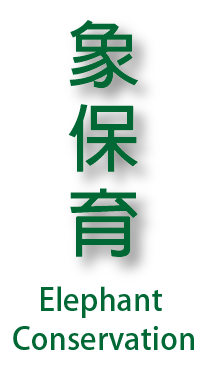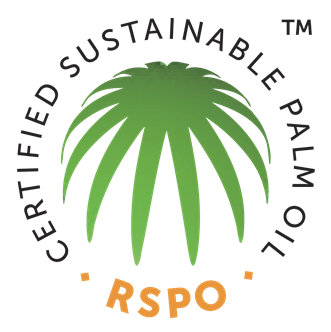國際行動
A Global Movement
保育團體
Wildlife Conservation Organizations
WWF 世界自然基金會 World Wildlife Fund
全球最知名的民間保育團體,透過宣導及募款的方式,來推動基因、物種、生態多樣性保育及永續發展等工作。
The WWF is one of the best known non-government conservation organizations. Through education and fundraising, the WWF promotes the conservation of genes, species, bio-diversity, and sustainable development.
關於保育非洲象,WWF在非洲執行以下計畫:
In Africa, the organization has been conducting the following initiatives:
加強阻止盜獵和非法象牙交易的活動。
Enforcing efforts to stop poaching and the ivory trade.
調查象群的狀況。
Surveying elephant populations.
減少人類和大象之間的衝突。
Reducing conflicts between humans and elephants.
減緩棲息地的喪失。
Reducing the loss of elephant habitats.
提升管理當局的保護和管理大象能力。
Enhancing government capabilities to protect elephants.

TRAFFIC 國際野生物貿易調查組織 (Trade Records Analysis of Flora and Fauna in Commerce)
每年非法的野生動植物貿易額大約在100億至200億美元之間。國際野生物貿易調查組織的主要任務即是對此市場進行監測工作,而非法的野生動植物貿易更是重點工作。他們的工作還包含分析野生動植物的貿易趨勢、模式和影響,以提供各國政府在維護自然資源的相關建議,及透過指導溝通來阻止消費者購買非法野生動植物產品。
The annual illegal global wildlife trade is worth somewhere between 10 billion and 20 billion US dollars. The program’s mission is to monitor global markets with a special emphasis on illegal trade. Its tasks include analyzing market trends, identifying modes of transactions, and predicting subsequent impacts of these activities. TRAFFIC provides recommendations to governments for the protection of natural resources and stopping illegal wildlife trade through consumer advocacy.
1989年瀕臨絕種野生動植物國際貿易公約CITES(又稱華盛頓公約)禁止一切象牙貿易。
In 1989, CITES (Convention on International Trade in Endangered Species of Wild Fauna and Flora, also knows as the Washington Convention), declared all ivory trade illegal.

世界自然保育聯盟 The International Union for Conservation of Nature (IUCN)
由許多國家的政府機構及民間團體所組成,以保護自然的完整性與多樣性,並確保自然資源合理使用及永續發展為宗旨。IUCN所發布的紅色名錄,為評估各物種的絕種風險,目的在於反映保育工作的迫切性,並協助避免物種滅絕。
世界自然保育聯盟在2016年夏威夷的世界保育大會上,決議呼籲世界各國應立即禁止國內象牙貿易。希望能藉此喝止大象盜獵,這也是世界自然保育聯盟,首次要求世界各國關閉境內合法的象牙市場。
This organization is made up of many government bodies and NGO’s worldwide with a mission is to protect the integrity and diversity of nature and to ensure the responsible consumption of the earth’s resources in a sustainable manner. It publishes the IUCN Red List of Threatened Species that assess animals’ risks of extinction in order to promote a sense of urgency for wildlife protection and to save endangered species. At the 2016 World Conservation Congress held in Hawaii, the IUCN passed a landmark resolution demanding the ban of domestic ivory sale by every government in the world. This was the first time the organization called for an end of the legal ivory trade and an aggressive attempt to stamp out elephant poaching.
(行政院農業委員會公告,自2020年1月1日起全面禁止國內象牙交易)
(The Agricultural Council of the Executive Yuan announced a domestic ban on sales of ivory, taking effect January 1, 2020.)

追蹤大象
Tracking Elephants
要保育大象,首先要了解大象的數量及生活區域,在非洲拯救大象的組織,為大象戴上衛星定位發射器,先麻醉安眠大象,等大象睡著後,在牠們的脖子戴上追蹤項圈,通常選定領頭的母象作為配戴衛星定位的對象。拯救大象的組織可以透過信號了解大象所在位置、遷徙路徑、是否前往村莊方向,並與直升機搭配統計象群數量。
Monitoring elephant population sizes and active territories is essential to protecting elephants in Africa. Researchers first select target elephants, usually the herd leaders and tranquilize them before attaching transponders to their necks. Researchers can then track elephant positions, migration paths, and their proximity to human populations. They can also perform counts using helicopters.
拯救大象的組織不止統計大象的數量,還長期觀察記錄象群,在肯亞的桑布魯國家自然保育區,記錄在此的大象年紀、彼此關係、性格等,拯救大象組織每天清點在保護區的大象,但不是每隻象每天都會出現,會隨著季節、環境變化而出現或離開。
Besides conducting population counts, some organizations track and record elephant herds over the long term. In Samburu National Reserve in Kenya, researchers record elephants’ age, relationships, personalities, and conduct daily counts of elephants in the park. Elephants may enter or leave the reserve area depending on weather and changes in the environment, so not every elephant can be accounted for every day.
誓死守護
Sworn to Protect
有鑑於野生動物遭受盜獵而數量減少,為了保護野生動物,在非洲設有許多自然保護區,在那裡大象、犀牛、獅子、斑馬、長頸鹿都生活在一起。自然保護區的範圍涵蓋好幾個國家,除了各國的官方保護機構,還有幾個組織如北部草原保護基金會、拯救大象組織(Save the Elephant)等共同合作來保護野生動物。
此外,為了更積極的保護大象,還設有反盜獵的巡邏員保護牠們。巡邏員首先要和當地的居民保持良好關係,以獲取大象的消息,或是打聽是否有非該區的居民進入,在巡邏時,仔細觀察在區域內的腳印是在地村民還是盜獵者,並且拆除盜獵者設下的陷阱。一旦發現要傷害大象的盜獵者,他們就會為保護大象挺身而出,為牠們犧牲也在所不惜。所以當你阻止盜獵的行為,就等於保護反盜獵巡邏員的生命。
With wildlife populations decreasing due to poaching, international sanctuaries have been set up across Africa where elephants, rhinoceroses, lions, zebras and giraffes coexist. These sanctuaries are maintained by organizations such as the Northern Rangelands Trust and Save the Elephant that work with government agencies.
Furthermore, to become more proactive in protecting the elephants, anti-poaching rangers patrol the reserves to protect them, working with local residents to gather news about elephants and identify suspicious human newcomers to the area. During their patrols, rangers identify poachers’ footprints and remove elephant traps. If poachers are located, rangers can often find themselves in life threatening confrontations. Ivory poaching endangers both elephants and humans and an end to poaching saves both elephants and park rangers.
人象共存的智慧
The Wisdom of Elephants and Humans Living Side-by-side
大象的數量減少有兩大原因,一是因盜獵象牙殺害大象,另一個是人象衝突產生而殺害大象。隨著人口增加,原本大象的棲息地被開發成村莊及農田,大象只是依循著記憶的路線去覓食,途中發現農田,有現成的食物便會自然的吃起來;而村民為了自保,對大象投擲石塊、爆竹或開槍試圖嚇跑牠們,但往往兩敗俱傷。有些地區為了防止大象破壞農田,在農地周圍圍起電網,讓大象因觸電而害怕不敢靠近,有大象因此被電死,但也有些大象利用不導電的象牙,輕鬆的破壞電網。這方法不但無法有效阻止大象,不小心也會造成大象死亡。
The two major causes of elephant population decline are poaching and conflict with humans. As human populations grow, farms and villages encroach on areas where elephants used to roam free. Elephants follow familiar routes when they forage. It is only natural for the elephants to eat agricultural crops that pop up along the way, regardless if the crops are human properties. To protect their crops, farmers try to scare elephants away by throwing rocks, setting off firecrackers, or even firing bullets. However, these direct confrontations usually end badly for both humans and elephants. Some farmers have set up electric fences to repel advancing elephants, causing many elephants to be electrocuted. Nevertheless, many elephants can easily break through the fences using their non-conductive tusks. Fences are not effective in stopping elephants and may inadvertently kill them.
為了減少人與象之間的衝突,拯救大象組織研究發現大象害怕蜜蜂,播放蜜蜂的聲音時,大象會趕緊離開並通知其他夥伴注意。於是研究團隊執行了大象和蜜蜂計畫,製作蜜蜂圍欄以便阻止大象,希望透過阻止大象入侵,減少人象衝突,沒有衝突自然能和平共處。
In order to reduce conflict with humans, elephant protection groups have developed “beehive fences”. Researchers have found that elephants flee the buzzing sound of bees and warn off their companions. Protection groups worked with researchers to carry out programs for bees and elephants at the same time. Protecting crops using bees reduces undesirable encounters between elephants and farmers, allowing both to coexist.
蜜蜂圍欄的製作方式很簡單,利用當地既有的材料,以每10公尺懸掛一個蜂巢箱,並將每個蜂巢箱以網路的型式連結,當大象經過碰到其中的線,因為連動的關係,所有的蜂巢受到拉扯而搖晃,裡面的蜜蜂就全跑出來,大象不想被螫也只好趕緊離開。蜜蜂圍欄這個方法成功阻擋大象的次數高達80%,也成功減少人和大象之間的衝突。
A beehive perimeter is simple to set up. Using local materials, beehive boxes are placed at 10 meter intervals and connected with strings. When an elephant bumps into a string, all connected beehives are moved. Bees fly out of their boxes in self-defense, forcing elephants to make a hasty retreat. This technique has successfully reduced confrontations with humans by 80%.
架設蜜蜂圍欄帶來的好處 :
Benefits of Beehive Fences

減少大象入侵 破壞農作物,增加農作物產量。
Reducing elephants’ destruction of crops and increasing harvests.
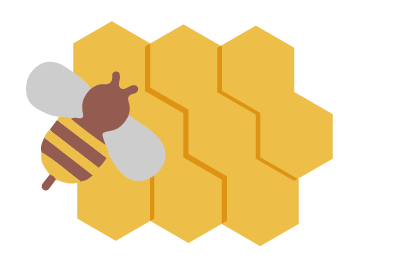
透過販賣蜂蜜、蜂蠟產品增加農民額外收入。
Increasing farm revenue from the sale of honey and beeswax products.
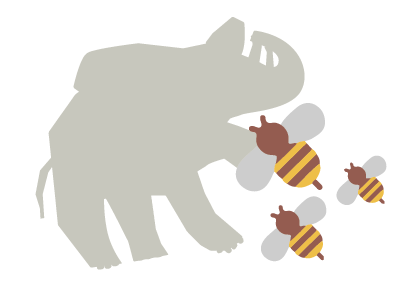
減少人和象的衝突,提升村民生活品質。
Reducing conflicts with elephants and improving quality of life for farmers.
參與執行蜜蜂圍欄計畫的國家有肯亞、波札那、查德、加彭、馬拉威、莫桑比克、南非、印度、斯里蘭卡、泰國,其他國家像尚比亞及尼泊爾也正討論架設蜜蜂圍籬。
Countries that have implemented the beehive fence program include Kenya, Botswana, Chad, Gabon, Malawi, Mozambique, South Africa, India, Sri Lanka and Thailand. Zambia, Nepal and other countries are also evaluating the viability of beehive fences.

動物園的合作計畫
Partnership Programs with Zoos
世界最小的象
The World’s Smallest Elephants
婆羅洲矮象主要分布於婆羅洲島北部的沙巴州,目前只剩下1500頭左右,是非常需要保護的瀕危物種。但是由於市場上對於棕櫚油的需求,讓婆羅洲島上的熱帶雨林被大量砍伐改種油棕,讓婆羅洲矮象喪失了棲息地,連帶著產生牠們跟人類之間的衝突。
不喜歡牠們單純路過擾亂油棕園、吃油棕等的業者於是以非法陷阱、毒殺、射殺等方式獵殺牠們,讓牠們面臨更多的生存危機。特別是往年只有單純獵殺,近年來卻由於黑市象牙的需求,讓以往只是棄置的大象屍體上的象牙也被採走,甚至只是為了象牙而盜獵。
The Borneo pigmy elephant is mostly found in the Malaysian state of Sabah, and with only about 1500 animals remaining is on the brink of extinction. Due to the high demand for palm oil, Borneo’s tropical rainforest is being continuously reduced to make room for palm oil plantations. Conflicts between Borneo elephants and palm farmers have become rampant. Displeased with elephants trespassing into palm plantations, farmers resort to means such as illegal traps, poison and guns to slaughter the elephants. The intensity of the slaughter has been heightened in recent years as the black market for ivory flourishes. Tusks that used to go to waste alongside elephant carcasses are now scavenged and extracted.
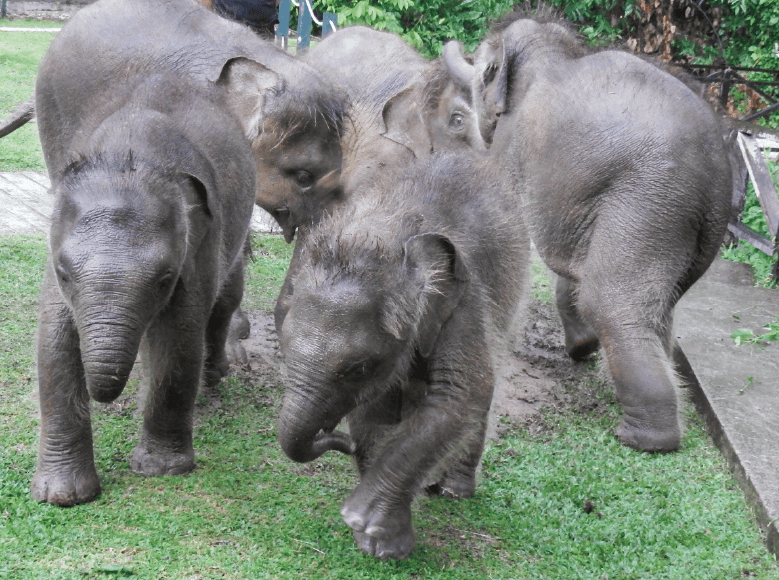
救救大象不能等
Elephant Protection Can’t Wait
為了要保育婆羅洲矮象,從21世紀初期起,就有一些單位,例如世界自然基金會、婆羅洲保育信託(BCT, Borneo Conservation Trust)開始透過各種方式在沙巴買地造林,想要把零碎的天然林連結成為生態廊道,好讓以婆羅洲矮象及其他物種在森林中來去,減少傷亡及人獸衝突。
Since the turn of the century, some organizations have been established to protect Borneo’s elephants. The WWF and Borneo Conservation Trust (BCT) have begun purchasing rainforest in Borneo to create eco-corridors that allow safe passage for elephants and other animals in the hopes of reducing encroachment on farms and plantations.
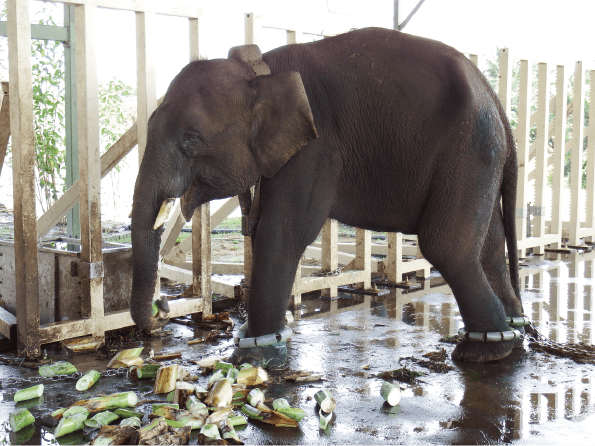
日本北海道旭山動物園的坂東元園長在2008年還是副園長的時候,為了想看動物園裡飼養的紅毛猩猩的故鄉及野生紅毛猩猩的現況而造訪沙巴,卻發現了婆羅洲矮象迫切需要保育的現況,於是開始與婆羅洲保育信託日本分會(BCTJ)合作報恩計畫(Ongaeshi Project),除了向企業募款以外,也在旭山動物園裡及日本各地設置了200個募款型自動販賣機,只要是在這種外面貼著報恩計畫圖像的自動販賣機買飲料等,扣掉成本以外的收入全部都會用在婆羅洲矮象的保育上面。這種自動販賣機的募款金額,平均每年在800萬日圓左右。
In 2008, the deputy director of Japan’s Asahiyama Zoo visited Sabah to study the natural habitats for orangutans. On the trip, he learned about the urgency to protect Borneo elephants, and the zoo began the Ongaeshi Project fund raising initiative in partnership with Borneo Conservation Trust Japan (BCTJ). Including a corporate donation campaign and revenue generation through vending machines, profits from 200 Ongaeshi Project vending machines inside the Asahiyama Zoo have been used for the protection of Borneo elephants, reaching an average of 8 million yen each year.
這筆基金起初先用來製造了兩個移動式欄舍,在接到通報有大象需要救傷或是移動的時候,先用這種欄舍捕捉,再直接帶去合適的地點野放。接下來則是在距離沙巴東部山打根車程大約兩小時的地區蓋了一個救傷中心(BES, Borneo Elephant Sanctuary),讓沙巴野生動物管理局有地方可以收容救傷大象加以治療、復健,以待野放回森林之日。這個救傷中心也已經在2014年9月啟用。
The fund was initially used to build two mobile fences used to capture elephants that have been injured or in need of relocation. The second initiative was the establishment in 2014 of the Borneo Elephant Sanctuary. Located 2 hours away from Sandakan (located on the east coast of the state of Sabah), the center provides accommodation and veterinary treatment for injured elephants before their release back into the wild.


臺北市立動物園在2015年9月跟日本北海道旭山動物園簽訂友好協定,其中的主要目標之一就是保育婆羅洲矮象,以及牠們的原生棲息地——婆羅洲沙巴的熱帶雨林。因為沒有了棲息地,野生動植物就沒有了家。
Taipei City Zoo entered into a partnership agreement with Asahiyama Zoo in September 2015. A main mission of the partnership is the protection of Borneo elephants and their natural tropical rainforest habitat. Without habitat, wildlife will be left without a home.
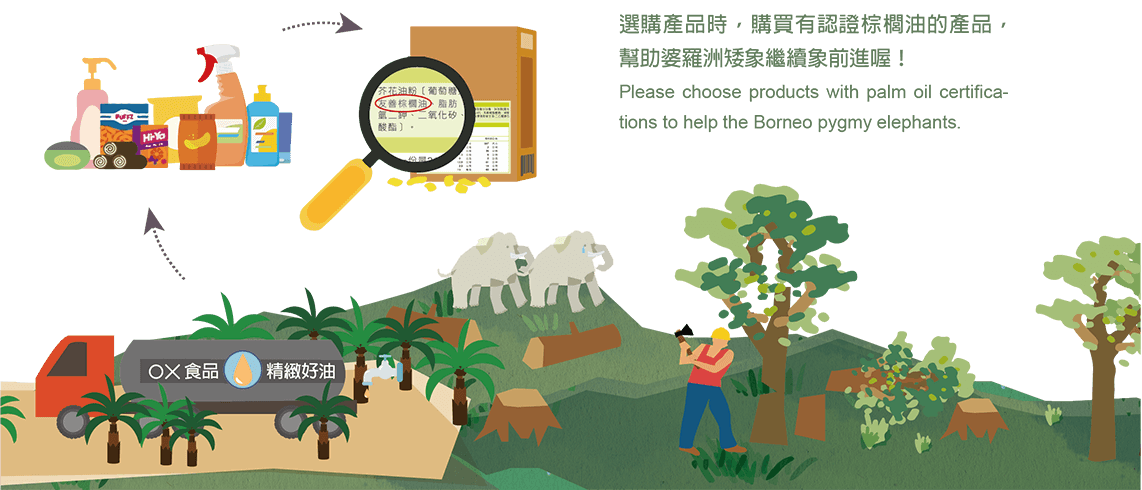
將心比象
Caring for Elephants
舉手投足
One Move at a Time
動物對於醫療很懼怕,從林旺及馬蘭的照顧經驗了解到大象的體型龐大、體重又重,若要大象做什麼事,不但要花費很多人力,還要隨時注意自身安全。尤其在馬蘭生病時,更發現「動物訓練」的重要。所謂動物訓練並非像馬戲團要求動物以表演為訓練,而是以醫療需求及動物福祉方面來規劃動物訓練。
Animals often show their fear towards any attempt towards the implementation of medical care. Caring for Lin Wang and Malan has provided zoo keepers invaluable insights into caring for elephants. Because of their massive bodies, it’s difficult to get elephants to follow the veterinarian’s directions. Treating sick elephants can even put workers in harm’s way. While treating Malan’s illness, the zoo learned of the importance of regular training for elephants. These training regimens are not meant for entertainment like in the circus, but are instead to ensure everyone’s safety during medical treatment.
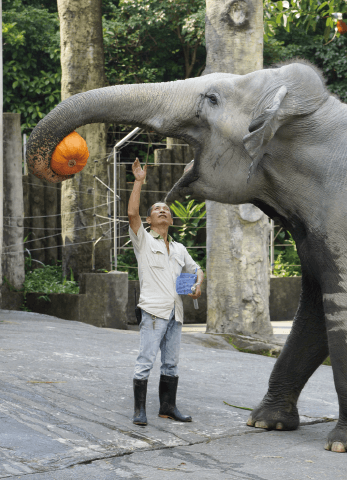
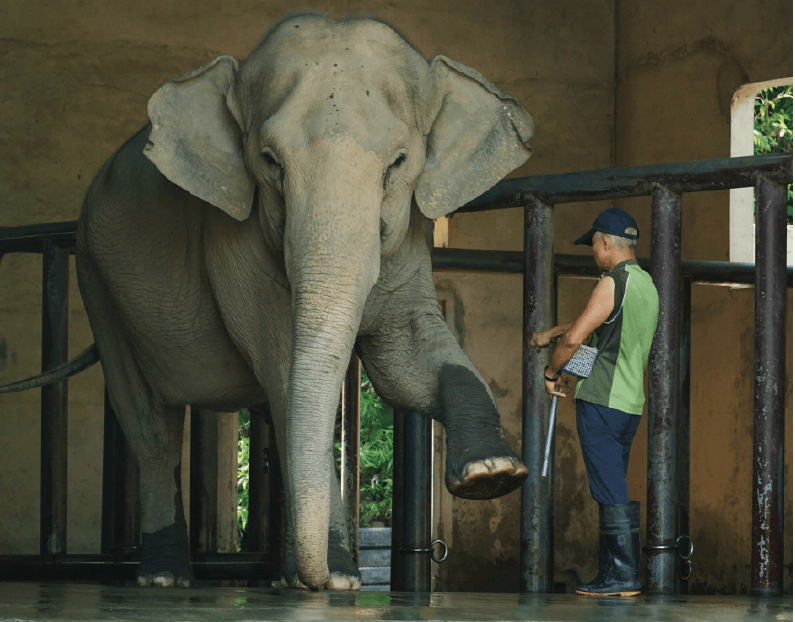
動物訓練需以循序漸進、不間斷的方式操作,並以正面鼓勵的方式進行。即便大象很聰明,但畢竟人與象無法直接用語言溝通,牠們聽不懂我們希望牠們做什麼,不過可以透過食物獎勵的方式來誘導,當牠們做「對」動作時,會得到獎勵來加強記憶,每次一點一點不斷反覆訓練,把動作分解一步一步進行,讓牠們從訓練變成習慣動作時,就能聽從保育員的指令進行倒、臥等動作,讓保育員觀察大象的狀態、配合張嘴進行牙齒健康檢查、抬腿讓獸醫或保育員進行修甲保養或其他的醫療行為。
Animal training needs to make use of incremental and consistent rewards, because as intelligent as elephants may be, they can’t directly understand human commands. Using food as a reward when they do the “right” thing, zoo keeper can incrementally guide elephants to take the positions required for medical treatment. For example, elephants need to lie down for examinations, open their mouths for dental checkups, and lift their feet for foot care. Training needs to be conducted every day until elephants can follow the zoo keeper’s commands.
延伸小知識 Extended knowledge
為了保育員的安全,大象的保育員以團隊在進行照顧及動物訓練,一位負責訓練大象動作,另一位則在旁邊觀察牠們的互動,而且不能隨意更換保育員。大象很聰明,牠們可是會認人的喔!
In order to ensure safety of zoo keepers, keeper work in pairs when looking after elephants. One keeper trains the elephant while the other watches. Zoo keepers can’t be easily replaced because elephants can recognize individual humans.
大象健身房
Elephant Gym
為了讓動物園中的動物有不同的活動刺激,讓牠們的生活類似野外一般,會進行讓動物行為更豐富的研究和設計,所謂的行為豐富化,是指在觀察與了解動物的習性及本能後,為動物量身打造的照顧及管理方式。如:改善空間打造更適合的環境;增加活動設施,讓牠們像在野外的活動方式;改變管理模式,依各別動物狀態去規劃執行,以動物福祉的角度去設想。讓民眾到動物園所看到的動物狀態比較接近在野外生活的情形。
動物園為大象規劃的行為豐富化包含有改善空間,例如在戶外展示場設置砂池、水池以滿足大象生活需求;增加活動設施,例如放置輪胎讓牠們活動,透過踩輪胎、舉輪胎的動作,讓大象活動筋骨,另外,在戶外展示區的天花板綁上裝有食物的桶子,大象聞到食物的味道,便會想盡辦法把裡面的食物弄出來,透過這樣的遊戲方式刺激大象的行為,行為豐富化的前提是這些活動設施都是不定期操作,才不會讓大象變成習慣喔。
Behavioral enrichment is the research and design related to creating stimulations and challenges to match the abilities and habits each individual species in the zoo. Also known as environmental enrichment, this practice includes modification of physical environments to simulate animals’ experiences in the wild. Caring for the welfare of each animal is the goal of every zoo, and allowing zoo visitors to see animals’ natural behavior in a way which reflects actual habits exhibited in natural wilderness environment.
Environmental enrichments for elephants in the zoo include an outdoor sand pool, a water pond and tires placed in their enclosure for elephants to lift and walk on for exercise. Food is placed inside buckets hanging from the ceiling; getting to the food is a game conducted from time to time that’s been designed to stimulate and challenge elephants, and to keep their foraging skills fresh. The prerequisite for behavioral enrichment is that the activity-related facilities need to operate on an irregular schedule to avoid elephants developing routine habits.

與象鬥智
Outsmarting an Elephant
馬蘭穿鞋
Malan’s Shoe
大象的腦容量比較大,真的比較聰明嗎?或許是真的,2000年馬蘭因腳疾開刀,手術完成後,獸醫每兩天為馬蘭泡腳換藥,馬蘭雖說是生病,但也不這麼聽話,牠會用象鼻把包紮傷口的繃帶撕開,連工作人員花了好幾個小時做的鋼片覆蓋板也都一起扯壞,為了與這大傢伙鬥智,工作人員想盡辦法在受傷的腿上綁上五顏六色的鋼絲,想要分散牠的注意力,但聰明的馬蘭沒花多久的時間便解開了。
馬蘭當時的傷口若不包紮固定,在牠的體重壓力下傷口往外張,即使長出新肉也無法癒合,在試了許多方法都無效後,決定為馬蘭做一隻醫療用的鞋子,讓牠碰不到傷口,傷口也能快點癒合。
Elephants are highly intelligent; just ask Malan’s keepers. After surgery to treat Malan’s foot in 2000, veterinarians had to apply medications to the elephant’s foot every second day, but Malan wasn’t exactly obedient and would take off the bandages using her trunk. Zoo keeper tried all kinds of techniques to keep the bandages on. They covered the foot with metal plates, they distracted Malan with colorful wires around the wraps, but the intelligent Malan managed to undo the bandages every time. Without pressure from the bandages, stepping on the foot would stretch the wound and cause it to reopen due to her weight. Malan’s foot couldn’t heal properly, and almost at their wit’s end, zoo veterinarian decided to create a custom shoe for Malan.
在這之前為馬蘭開刀時,就做了腳模,於是用這腳模找了製鞋廠商討論,馬蘭的鞋就在兩家熱心贊助的鞋商「阿瘦皮鞋」及「凱欣特舒鞋」製鞋師絞盡腦汁下製作完成。完成的醫療用鞋為圓筒狀直徑約35公分,跟一般鞋子一樣有鞋帶可以調整,製鞋師特別在傷口指甲的位置挖洞,另外以鞋帶固定,方便檢查傷口,醫療用鞋不但透氣、防水,最重要的是很強韌,這下馬蘭可無法把鞋子拆下了。
Two sponsoring shoe companies, A.S.O and Kai Shin, agreed to help with the project. A mold of the elephant’s foot had been made before the surgery that was used by shoe designers. The custom made elephant shoe resembled a cylinder 35cm in diameter which could be opened and removed using laces. The shoe was tough, water resistant, and breathable, with an opening near the toe to examine and treat the wound. Most importantly, Malan never figured out how to take the shoe off!

醫療鞋側邊開口以便檢查傷口
Openings on the side of the medical footwear allow wounds to be examined more easily.
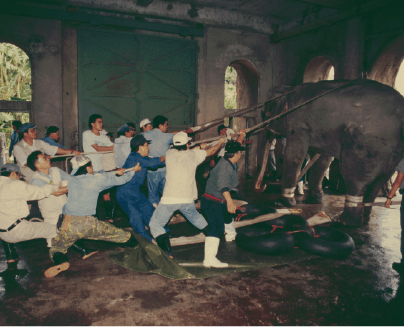
因為馬蘭體型龐大,手術時動用數十位工作人員合力完成。
Due to the enormous body size of Malan, the collaboration of over tens of staff members was necessary to perform the operation.
大象的麥片丸子
Oatmeal Balls
大象的重量靠著四隻腳支撐,所以腳部的健康對大象而言非常重要,為了改善大象象腳皮膚剝落的情形及補足食物中缺乏的微量元素,會以提供維他命的方式來補充。但大象不喜歡維他命的味道,總是能用靈敏的嗅覺聞到而避開不吃,要怎麼讓大象吃下足夠的維他命看來又是一場與象鬥智。
A lot of weight rests on an elephant’s feet. Foot health is extremely important for elephants. In order to prevent excessive skin peeling around the feet and to provide micronutrients that regular diets lack, the method adopted by zoo dieticians is to prescribe regular vitamins. But getting elephants to take their vitamins was another battle of wits at the zoo.
為了讓大象吃下維他命,保育員想到可以把維他命溶入水中,再撒到乾草堆上,看似大象吃下去了,但無法知道吃多吃少。接著嘗試將維他命夾在水果中,但還是被大象吐了出來,即便用蜂蜜等甜味包覆還是被大象拒絕。
Elephants don’t like vitamins, and they can detect them in their foods. Zoo keepers tried to mix vitamins in water and spray them on the elephants’ hay, but the flaw of this method was the inability to know which elephant ate the vitamin-soaked feed. Subsequently, zoo keepers tried concealing vitamins inside of fruits, but the elephants spat themback out. They also tried coating vitamins with sweet foods such as honey, but to no avail either.
但為了大象的健康得補充維他命才行,保育員絞盡腦汁想到可以參考治療猴子糖尿病時的麥片丸子方式,先將燕麥煮熟攪拌至黏稠,再加入綜合維他命粉,充分混合後捏成丸狀,這樣一來方便餵食,也能知道大象吃了多少的量,重點是大象不但不討厭還吃得津津有味。
The zoo keeper decided to borrow a lesson learned from treating monkeys with diabetes. They cooked oatmeal until it became thick and sticky, added vitamin powder, then heated and stirred the mixture until it became doughy. The mixture was separated and shaped into individual oatmeal balls, which turned out to be a hit! Not only did the elephants love them, their keepers could also easily monitor each elephant’s vitamin intake.

長鼻們的智慧
Elephant Wisdom
在英文的諺語中有一句「大象不會忘記(an elephant never forgets)」,英國知名的推理小說家阿嘉莎克莉絲蒂也以此為靈感而寫了小說《大象的證詞》(Elephants Can Remember)。這些都是因為大象一向被認為是很聰明的動物。實際上,也有不少研究都在討論大象是不是真的有很好的記憶力。而根據觀察,大象除了記得哪裡有食物、有水源以外,似乎也真的很會記憶其他的大象、也會記得人,特別是讓自己受傷的人。而牠們之所以會「侵入」人類住的村莊或農地,基本上也是因為那些地方是象群自很久以前就在走的路徑。
As the saying goes, an elephant never forgets. This was perhaps the inspiration for Agatha Christie when she wrote Elephants Can Remember. Elephants are believed to be highly intelligent and possess good memories, with research suggesting that elephants have the ability to remember the location of food and water, foraging routes, and identify and remember other elephants and humans. Elephants can also remember individuals that have caused them harm. Elephants may appear lost when they enter into human territories, but in fact humans are to blame for putting villages and plantations in their regular paths.
雖然大象走過的地方,樹可能會被連根拔起或是因為樹皮被剝掉而乾枯,但是也因為如此,才讓位於森林下層的小樹苗和其他植物能夠長大,促進森林演替。
Wherever elephants pass, trees may be uprooted or die from having their bark stripped. But this is a healthy process that helps younger trees and plants grow as the jungle rejuvenates.
缺一不可
Everyone Can Make a Difference
動物園是啟發許多人認識動物、愛上動物的第一個地方。動物園扮演的「現代方舟」角色,除提供民眾「休憩」場所之外,更重要的是積極發展「保育、教育、研究」功能,將動物園內的域外保育努力回饋及連結至野生動物原生棲地的域內保育。但是這樣的工作,絕對不可能是一個人、一個動物園、一座城市就能辦到的。除了大象以外,地球上還有非常多的動植物也正面臨著生存危機。
Many people have discovered their love for animals at the zoo. Zoos function as destinations for leisure and enjoyment and, more importantly, as centers for education, research, and conservation, helping to reciprocate the zoo’s effort in Ex-Situ conservation and connecting to the respective wildlife’s In-Situ conservation. Zoos are like modern arks. However, no single organization or even city government has enough resources to support zoos’ new missions. There are many animal and plant species besides elephants that are endangered. As a result, partnerships are being established between zoos around the world.
臺北動物園目前除了跟日本旭山動物園合作婆羅洲矮象域內保育計畫外,還參與歐洲動物園暨水族館協會(EAZA)的歐洲瀕危物種保育計畫(EEP),在全球分工下將非洲野驢引進臺北繁殖;在金剛猩猩保種計畫中,把臺北的金剛猩猩「寶寶」送至荷蘭靈長類公園,另從波蘭歐普勒動物園引進迪亞哥,這些都是為了要讓野外的基因有機會傳承、增加域外族群的基因多樣性。除此之外,與美國貝爾勒龜類保育中心的瀕危龜類保育繁殖存續計畫合作緬甸星龜保育,和日本東京多摩動物公園合作黑面琵鷺保育,都只是眾多保育計畫的一部分。野生動物保育人人有責,缺一不可。
Taipei Zoo has partnered with Japan’s Asahiyama Zoo in a program to save the Borneo elephants. It also has partnered with The European Association of Zoos and Aquaria (EAZA) in its European Endangered Species Programme (EEP). Under a worldwide division-of-labor arrangement, Taipei Zoo has received an African wild donkey for propagation; sent Bao Bao the gorilla to Apenheul Primate Park in the Netherlands as a part of the gorilla conservation plan, and welcomed D’jeeco the gorilla from Poland. These efforts provide these endangered species access to greater genetic diversity through breeding. Taipei Zoo has also partnered with the Behler Chelonian Center in a program to breed the Burmese star tortoise, and with Japan’s Tama Zoological Park to protect the black-faced spoonbill. When it comes to endangered species protection, everyone must play a role.
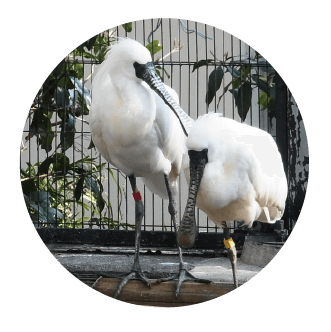
黑面琵鷺 Black-Faced Spoonbill
日本東京多摩動物公園合作保育計畫
Tokyo Tama Zoological Park Cooperative Conservation Programme
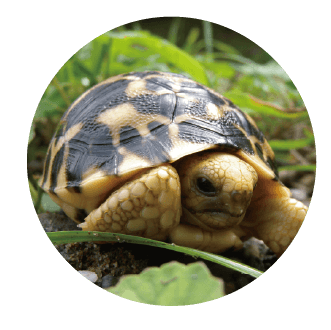
緬甸星龜 Burmese Star Tortoise
美國貝爾勒龜類保育中心所屬瀕危龜類保育繁殖存續計畫
Programme of Endangered Turtle Conservation and Breeding in the Behler Chelonian Center in the United States
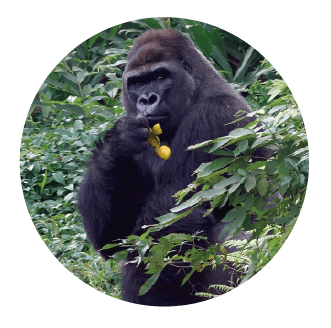
金剛猩猩 Gorilla
金剛猩猩歐洲瀕危物種保育計畫
EAZA Gorilla EEP, European Endangered Species Programme
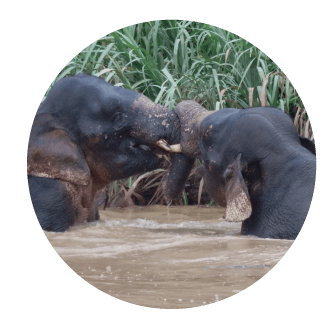
婆羅洲矮象 Borneo Elephants
馬來西亞沙巴州政府與日本北海道旭山動物園合作婆羅洲矮象保育計畫
Sabah State Govemment of Malaysia Cooperates with Asahi Zoo in Hokkaido,Japan, Bomeo Elephants Conservation Programme
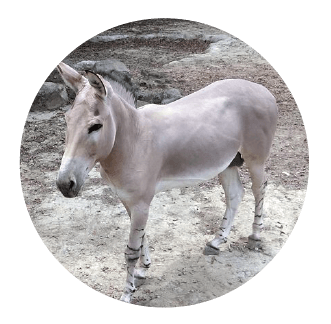
非洲野驢 African Wild Ass
歐洲動物園及水族館協會索馬利非洲野驢物種保育計畫
European Association of Zoos and Aquaria Somali Wild Ass Species Conservation Programme


